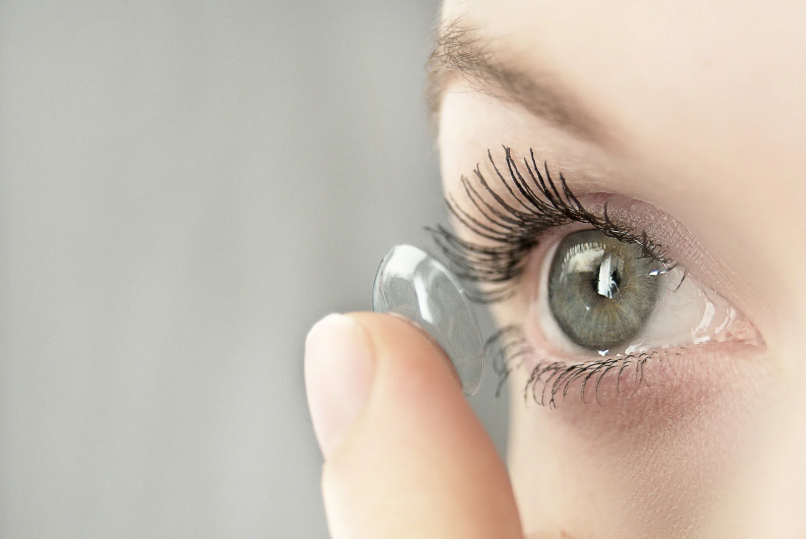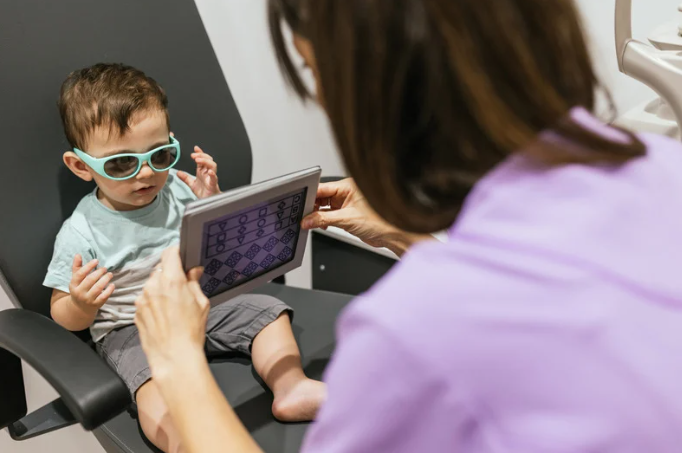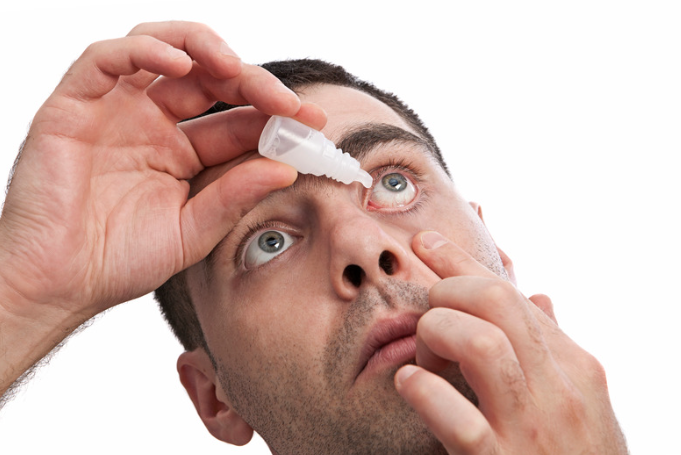Tips for Preventing Dry Eyes While Wearing Contact Lenses
Wearing contact lenses can be a convenient and aesthetic alternative to glasses, but for many users, dry eyes become a persistent issue. The lack of sufficient moisture in the eyes can lead to discomfort, irritation, and even difficulty wearing lenses for extended periods. To ensure comfortable wear, it’s essential to find solutions such as the best eye drops for dry eyes, proper hydration, and suitable lens choices. In this blog, we will explore the causes of dry eyes with contact lenses and how to manage them with dry eye drops and other practical solutions.
Why Do Contact Lenses Cause Dry Eyes?
Contact lenses sit directly on the cornea, reducing the amount of oxygen that reaches the eye’s surface. This can lead to dry eyes, especially for individuals who already have low tear production. Some common reasons include:
Reduced Blink Rate: Wearing contact lenses can subconsciously reduce blinking, leading to faster tear evaporation.
Lens Material: Some contact lenses absorb moisture from the eyes, contributing to dryness.
Environmental Factors: Air-conditioning, dry climates, and prolonged screen time can worsen dry eyes while wearing lenses.
Improper Lens Care: Not cleaning lenses properly or wearing them longer than recommended can lead to irritation and discomfort.
Using eye care drops specifically designed for contact lens users can help maintain moisture and ensure a comfortable wearing experience.
Choosing the Right Contact Lenses to Prevent Dry Eyes
Selecting the appropriate type of contact lenses can significantly reduce dry eyes and improve comfort. Here are some options:
1. Silicone Hydrogel Lenses
These lenses allow more oxygen to pass through to the cornea, reducing the likelihood of dry eyes and irritation.
2. Daily Disposable Lenses
Using fresh lenses each day minimizes the risk of protein buildup, which can exacerbate dry eyes and discomfort.
3. Soft Contact Lenses with Moisture Retention
Certain brands manufacture lenses with hydration technology, designed to retain moisture and keep the eyes lubricated.
Pairing these lenses with the best eye drops for dry eyes ensures prolonged comfort throughout the day.
Practical Tips for Comfortable Contact Lens Wear
1. Maintain Proper Lens Hygiene
Keeping lenses clean prevents irritation and dryness. Follow these steps:
Use the recommended lens solution to clean your contacts daily.
Replace lenses as per the prescribed schedule.
Avoid sleeping with contact lenses unless they are specifically designed for overnight wear.
2. Stay Hydrated
Drinking plenty of water throughout the day ensures adequate tear production, preventing dry eyes while wearing lenses.
3. Blink More Often
When focusing on screens or reading, blink consciously to keep your eyes moist. Consider using dry eye drops before prolonged screen use.
4. Reduce Screen Time
Staring at digital screens for long hours can worsen dry eyes. Follow the 20-20-20 rule: Every 20 minutes, look at something 20 feet away for at least 20 seconds.
When to See an Eye Specialist
If dry eyes persist despite using the best eye drops for dry eyes and following these tips, consult an eye doctor. Signs that indicate a need for professional help include:
Redness, itching, or persistent discomfort.
Difficulty wearing lenses for more than a few hours.
Blurred vision or light sensitivity.
Frequent eye infections.
An eye specialist can recommend the best treatment, including prescription eye care drops or alternative lens options.
Additional Strategies to Prevent Dry Eyes with Contact Lenses
Beyond using the best eye drops for dry eyes and maintaining proper lens hygiene, there are additional lifestyle and dietary adjustments that can help combat dry eyes and ensure comfortable lens wear.
1. Nutritional Support for Healthy Eyes
Your diet plays a crucial role in maintaining eye moisture and reducing dry eyes while wearing contact lenses.
Essential Nutrients for Eye Hydration
Omega-3 Fatty Acids: Found in fish like salmon and flaxseeds, omega-3s help improve tear quality and reduce inflammation that contributes to dry eyes.
Vitamin A: Found in carrots, sweet potatoes, and leafy greens, this vitamin supports healthy tear production.
Vitamin C & E: Citrus fruits, nuts, and seeds provide antioxidants that protect eye health.
Zinc: Found in chickpeas and shellfish, zinc supports vision and eye function.
A diet rich in these nutrients, combined with dry eye drops, can significantly improve eye hydration.
2. The Role of Hydration in Contact Lens Comfort
Staying hydrated is essential for eye moisture. Dehydration can lead to dry eyes, making lens wear uncomfortable.
Tips to Stay Hydrated:
Drink at least 8 glasses of water daily to maintain tear production.
Limit caffeine and alcohol intake, as they contribute to dehydration.
Eat water-rich foods like cucumbers, watermelon, and oranges.
Pairing hydration with the best eye drops for dry eyes ensures all-day comfort when wearing lenses.
3. Environmental Adjustments to Reduce Dry Eyes
Your surroundings can significantly impact dry eyes, especially when wearing contact lenses.

How to Create an Eye-Friendly Environment:
Use a Humidifier: Adds moisture to dry indoor air, reducing eye irritation.
Avoid Direct Airflow: Fans, heaters, and air conditioning can dry out the eyes. Adjust their position to prevent direct exposure.
Wear Sunglasses Outdoors: Protects against wind and UV exposure, both of which can contribute to dry eyes.
Reduce Screen Glare: Use anti-glare filters on screens to minimize eye strain.
By adjusting your environment and using eye care drops, you can maintain comfortable lens wear throughout the day.
4. Alternative Solutions for Dry Eyes with Contact Lenses
If you experience persistent dry eyes despite using dry eye drops and hydration techniques, consider alternative solutions:
1. Scleral Contact Lenses
These lenses are larger and create a moisture reservoir, offering relief for individuals with severe dry eyes.
2. Hybrid Contact Lenses
A combination of rigid and soft lenses, these provide better comfort and moisture retention.
3. Orthokeratology (Ortho-K)
These are specialized lenses worn overnight to reshape the cornea, reducing the need for daytime contacts and minimizing dry eyes.
4. Prescription Eye Care Drops
If over-the-counter dry eye drops aren’t effective, an eye specialist may recommend medicated eye care drops for long-term relief.
5. Myths and Misconceptions About Contact Lenses and Dry Eyes
Myth 1: Only People with Pre-Existing Dry Eyes Experience Discomfort
Even individuals with normal tear production can develop dry eyes due to prolonged lens wear or environmental factors.
Myth 2: All Eye Drops Work for Contact Lens Wearers
Not all eye care drops are suitable for lenses. Some contain preservatives that can cause irritation. Always choose the best eye drops for dry eyes labeled for contact lens users.
Myth 3: Contact Lenses Are the Only Cause of Dry Eyes
While contact lenses can contribute to dry eyes, factors like dehydration, excessive screen time, and aging also play a role.
Myth 4: There’s No Solution for Dry Eyes in Contact Lens Wearers
With dry eye drops, proper hydration, and lens selection, you can prevent dry eyes and enjoy comfortable wear.
When to Consider Switching to Glasses
Despite using the best eye drops for dry eyes, some individuals may find that contacts exacerbate dry eyes. Consider switching to glasses if:
Your eyes feel persistently irritated or painful.
You experience blurry vision even with adequate hydration.
Your eye doctor recommends giving your eyes a break.
Alternating between contacts and glasses can help prevent dry eyes and maintain long-term eye health.
Conclusion: Managing Dry Eyes for Comfortable Contact Lens Wear
Wearing contact lenses doesn’t have to mean suffering from dry eyes. By choosing the best eye drops for dry eyes, staying hydrated, maintaining proper lens care, and adjusting your environment, you can keep your eyes comfortable all day long.
If you continue experiencing dry eyes, consult an eye specialist for personalized solutions, including prescription eye care drops or alternative lenses. With the right approach, you can enjoy the convenience of contact lenses without discomfort!







